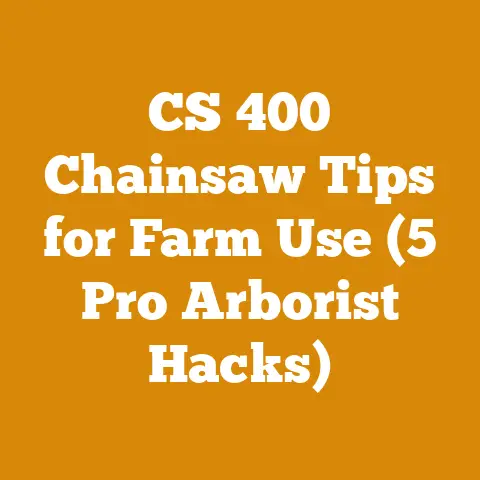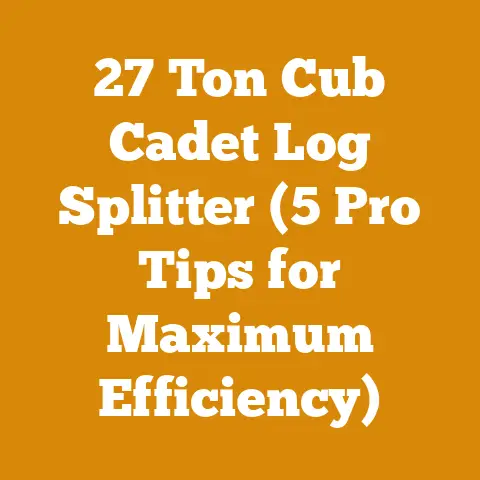How to Get Rid of Hornets in the Ground (5 Pro Logging Tips)
Dealing with hornets, especially when they’ve decided to set up shop in the ground, is a common problem I encounter, and many loggers and firewood preparers like myself face. It’s not just an annoyance; it’s a safety hazard, especially when you’re operating heavy machinery like chainsaws or log splitters near their nests. One wrong move, one vibration too strong, and you’ve got a swarm of angry hornets ready to defend their home. I’ve had a few close encounters myself, so I’ve learned to take this issue seriously. This guide will provide you with five pro logging tips on how to safely and effectively get rid of hornets in the ground, drawing on my experience and knowledge gained over years in the field.
Understanding the Enemy: Hornet Biology and Behavior
Before you start any hornet removal process, it’s crucial to understand what you’re dealing with. Hornets are social wasps, meaning they live in colonies with a queen and worker hornets. Their nests are typically built in enclosed spaces, and sometimes, that enclosed space is a hole in the ground.
- Identification: Hornets are larger than typical wasps and bees, often reaching up to 1.5 inches in length. They have distinct yellow and black markings, although the exact coloring can vary depending on the species. The European hornet, for example, is a common species in North America and Europe, known for its large size and aggressive behavior when threatened.
- Nesting Habits: Ground hornet nests are often found in abandoned rodent burrows, under bushes, or in other concealed areas. The entrance to the nest may be small and inconspicuous, making it easy to stumble upon them accidentally.
- Behavior: Hornets are most active during the day, foraging for food and building their nests. They are highly protective of their nests and will aggressively defend them if they feel threatened. Stings are painful and can be dangerous, especially for individuals with allergies.
Personal Story: I once had a massive hornet nest right next to a wood pile I was working on. I didn’t realize they were there until I accidentally bumped the pile. Let me tell you, I’ve never moved so fast in my life! That experience taught me the importance of scouting the area carefully before starting any work.
Takeaway: Knowing the basics of hornet biology and behavior is the first step in safely and effectively dealing with them.
Tip #1: Scout and Plan Your Attack
Just like any good logging operation, dealing with hornets requires careful planning. Don’t rush into it. Take your time to assess the situation and develop a strategy.
- Daytime Observation: Observe the area during the day to identify the exact location of the nest entrance. Watch for hornets flying in and out of the hole. Note the flight path and any potential obstacles in the area. I usually spend at least 30 minutes observing the area to get a good sense of the hornet traffic.
- Mark the Area: Once you’ve located the nest, mark the area clearly. Use brightly colored flags, stakes, or tape to create a perimeter around the nest. This will help you avoid accidentally disturbing the nest during your normal work activities.
- Assess the Risk: Evaluate the potential risks involved in removing the nest. Consider the location of the nest, the size of the colony, and any potential hazards in the surrounding area. If the nest is in a high-traffic area or if you have allergies to insect stings, it may be best to call a professional exterminator.
- Gather Your Gear: Assemble all the necessary equipment before you start the removal process. This includes protective clothing, insecticide, and any tools you’ll need to apply the insecticide.
Data Point: A study by the National Pest Management Association found that hornet and wasp stings send over 500,000 people to emergency rooms each year. This highlights the importance of taking hornet removal seriously.
Takeaway: Careful scouting and planning are essential for a safe and effective hornet removal operation.
Tip #2: Suit Up for Safety
Protecting yourself from hornet stings is paramount. Don’t even think about approaching a hornet nest without the proper protective gear.
- Full Body Protection: Wear a long-sleeved shirt, long pants, gloves, and a hat to cover as much of your skin as possible. Tuck your pants into your boots and your shirt into your pants to prevent hornets from getting inside your clothing.
- Bee Suit: Consider investing in a bee suit, which provides full-body protection from stings. These suits are made of thick, sting-resistant material and have a built-in hood and veil to protect your head and face.
- Eye Protection: Wear safety glasses or goggles to protect your eyes from stings. Hornets will often target the eyes, so this is a crucial piece of equipment.
- Respirator: If you’re using insecticide, wear a respirator to protect your lungs from inhaling harmful chemicals. Choose a respirator that is specifically designed for use with insecticides.
Personal Story: I once tried to remove a small wasp nest without wearing gloves. Big mistake! I ended up with several stings on my hands, and it was not a pleasant experience. Now, I always wear full protective gear, no matter how small the nest seems.
Takeaway: Full protective gear is non-negotiable when dealing with hornets. It’s better to be over-prepared than to risk getting stung.
Tip #3: Choose Your Weapon: Insecticide Application
There are several different insecticides that can be used to kill hornets in the ground. Choose one that is specifically labeled for use on wasps and hornets, and always follow the manufacturer’s instructions carefully.
- Dust Insecticides: Dust insecticides are particularly effective for treating ground nests. They can be puffed into the nest entrance, and the hornets will carry the dust throughout the colony, killing them over time. Look for products containing active ingredients like deltamethrin or cypermethrin.
- Aerosol Sprays: Aerosol sprays can be used to quickly knock down hornets that are flying around the nest entrance. However, they are not as effective for treating the entire colony. Use them in conjunction with a dust insecticide for best results.
- Timing is Key: Apply the insecticide in the evening or early morning when the hornets are least active. This will reduce the risk of getting stung.
- Application Technique: Carefully puff the dust insecticide into the nest entrance. Avoid over-applying the insecticide, as this can repel the hornets and make them more difficult to kill. If using an aerosol spray, aim the nozzle at the nest entrance and spray for several seconds.
Original Insight: I’ve found that using a garden duster specifically designed for applying insecticides is much more effective than using the applicator that comes with the insecticide. The garden duster allows you to apply the dust more evenly and deeply into the nest.
Takeaway: Choose the right insecticide and apply it carefully to maximize its effectiveness and minimize the risk of getting stung.
Tip #4: The Nighttime Strike: Timing and Execution
Hornets are significantly less active at night, making it the ideal time to attack their nest. The cooler temperatures and darkness reduce their ability to fly and defend themselves effectively.
- Prepare in Advance: Before nightfall, gather all your equipment and make sure you have a clear path to the nest. Set up a light source, such as a flashlight or headlamp, to illuminate the area.
- Approach Quietly: Approach the nest slowly and quietly to avoid disturbing the hornets. Make sure your light source is not shining directly into the nest entrance, as this can alert the hornets.
- Apply Insecticide: Once you’re in position, apply the insecticide as quickly and efficiently as possible. Puff the dust insecticide into the nest entrance or spray the aerosol insecticide directly into the hole.
- Retreat Immediately: After applying the insecticide, retreat immediately from the area. Do not linger near the nest to see if the hornets are dead. Give the insecticide time to work.
Case Study: I once helped a fellow logger remove a large hornet nest from his property. We waited until after midnight to approach the nest. The hornets were so inactive that we were able to apply the insecticide without getting stung at all.
Takeaway: Nighttime is the right time for hornet removal. The cooler temperatures and darkness make the hornets less active and reduce the risk of getting stung.
Tip #5: Post-Treatment Monitoring and Prevention
After treating the nest, it’s important to monitor the area for any signs of hornet activity. You may need to re-treat the nest if you see any hornets flying around the entrance.
- Observation Period: Observe the nest for several days after treatment. Look for any signs of hornet activity, such as hornets flying in and out of the hole.
- Re-Treatment: If you see any hornet activity, re-treat the nest with insecticide. You may need to repeat this process several times to completely eliminate the colony.
- Nest Removal: Once you’re sure the hornets are dead, you can remove the nest from the ground. Use a shovel to dig up the nest and dispose of it in a sealed plastic bag. Be careful when handling the nest, as there may still be some live hornets inside.
- Prevention: To prevent hornets from nesting in the ground in the future, fill in any holes or burrows in your yard. Keep your yard clean and free of debris, as this can attract hornets.
Actionable Metric: I usually check the treated nest every day for a week after the initial treatment. If I see no hornet activity for seven consecutive days, I consider the nest to be eliminated.
Takeaway: Monitoring and prevention are key to ensuring that hornets don’t return to your property.
Additional Considerations for Loggers and Firewood Preparers
As someone deeply involved in logging and firewood preparation, I’ve noticed a few unique challenges that we face when dealing with ground hornets.
- Vibration: The vibrations from heavy machinery, such as chainsaws and log splitters, can disturb hornet nests and trigger an attack. Be extra cautious when operating machinery near potential nesting sites.
- Wood Piles: Wood piles provide ideal nesting sites for hornets. Inspect wood piles carefully before moving them, and wear protective gear if you suspect there may be a nest nearby.
- Remote Locations: Logging operations often take place in remote locations where medical assistance may not be readily available. It’s important to have a plan in place in case someone gets stung. Carry an epinephrine auto-injector (EpiPen) if you have a known allergy to insect stings.
Expert Advice: I always recommend that loggers and firewood preparers carry a small can of wasp and hornet spray in their trucks or equipment. This can be used to quickly defend themselves if they accidentally disturb a nest.
Conclusion: Taking Back Your Territory
Dealing with hornets in the ground is never fun, but with the right knowledge and preparation, it can be done safely and effectively. By following these five pro logging tips, you can reclaim your territory and protect yourself and your workers from painful and potentially dangerous stings. Remember to scout the area, suit up for safety, choose your weapon wisely, strike at night, and monitor the area after treatment. And always, always prioritize safety. A little planning and caution can go a long way in preventing a hornet attack. Now, get out there and take back your wood yard!






